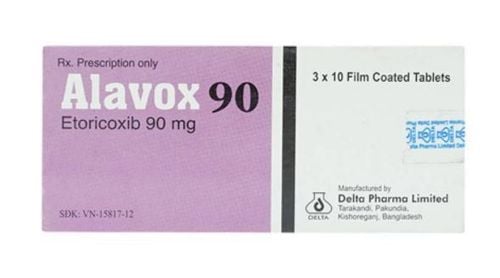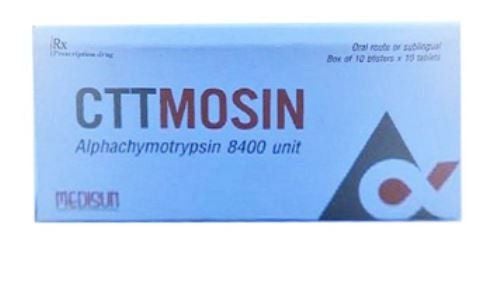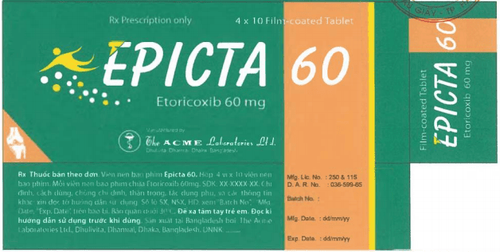This is an automatically translated article.
E cox 60 is a drug whose main active ingredient is etoricoxib, which has a selective inhibitory effect on cox-2, so it is used in the treatment of swelling and pain in osteoarthritis, acute pain, abdominal pain. terrible.
1. What is E cox 60?
E cox 60 belongs to the group of pain relievers-fever reducers, NSAIDs, drugs for treatment of Gout and joint diseases. It has the main active ingredient, etoricoxib, which selectively inhibits cox-2 (the inflammatory component). Therefore, the drug works to reduce swelling and pain caused by inflammation.
E cox 60 is indicated in the treatment of osteoarthritis, ankylosing spondylitis, acute gouty arthritis, acute and chronic pain relief, primary dysmenorrhea.
2. Dosage, how to use E cox 60
Dosage recommended by the manufacturer varies depending on the type of disease:
Osteoarthritis dose ranges from 30-60mg / time, 1 time / day. Rheumatoid arthritis, ankylosing spondylitis, maximum dose of 90 mg/time, 1 time/day. For pain relief after dental procedures, the dose should not exceed 90mg/time, once/day, up to 3 days. In acute gout, the dose should not exceed 120 mg/time, 1 time/day, up to 8 days. Acute pain, primary dysmenorrhea, dose not exceeding 120 mg/time, 1 time/day, up to 8 days. In case of liver failure with Child-Pugh index 5-6, the dose should not exceed 60mg/time, 1 time/day; Children with Child-Pugh index 7-9 reduce dose to 30mg/time, 1 time/day or not more than 60mg/time, 1 time/day, once every 2 days. No dose adjustment is required for the elderly and renal failure (ClCr ≥ 30ml/min).
3. Contraindications to the use of E cox 60
E cox 60 is contraindicated in the following subjects:
People with a history of hypersensitivity to etoricoxib and other components of the drug Have a history of allergy to aspirin or other NSAIDs People with congestive heart failure (NYHA II-IV) People with persistent hypertension > 140/9gmmHg that are not well controlled People with ischemic heart disease, peripheral artery disease, cerebrovascular disease, including those who have recently undergone bypass graft surgery. coronary artery or angioplasty. People with Child-Pugh index ≥ 10 or serum albumin < 25g/l People with advanced peptic ulcer, gastrointestinal bleeding People with severe kidney disease, with ClCr < 30ml/min
4. Side effects when using E cox 60
Some possible side effects during the use of E cox 60 include:
Thrombocytopenia Anaphylactic shock and other allergic reactions Hyperkalemia Anxiety, insomnia, somnolence, restlessness, confusion, hallucinations Taste disturbances Blurred vision Congestive heart failure, palpitations, angina pectoris Paroxysmal hypertension Bronchospasm Abdominal pain, mouth ulcers, vomiting, diarrhea, gastrointestinal ulcers including perforation and hemorrhage Hepatitis, jaundice, elevated AST/ALT Stevens-Johnson syndrome Toxic epidermal necrolysis, urticaria
5. Be careful when using E cox 60
When using the drug in higher doses and for a longer time, the risk of cardiovascular complications also increases. Therefore, patients should pay attention to choose the lowest dose and shortest time while still achieving high efficiency. E cox 60 does not replace aspirin in the prevention of cardiovascular complications, because it has no effect on platelets.
During treatment, it is necessary to monitor water retention, edema, and hypertension in people who already have water retention, heart failure. For patients with reduced renal function, decompensated heart failure, cirrhosis, continuous monitoring of renal function is required. For pregnant women, the benefits and risks need to be weighed before deciding to take the drug, and nursing women should stop breastfeeding while taking the drug.
6. Drug interactions
Possible interactions when using E cox 60 with other drugs. Therefore, before starting to use the drug, tell your doctor about the medications you are taking. E cox 60 may interact with the following drugs:
Anticoagulants such as warfarin Antibiotics Rifampicin Methotrexate, an immunosuppressant commonly used in the treatment of rheumatoid arthritis Medicines to control blood pressure and heart failure including ace inhibitors (enalapril, ramipril) and angiotensin receptor blockers (losartan, valsartan) Lithium to treat some depression Water-based diuretics Ciclosporin or tacrolimus is an anti-rejection, immunosuppressant drug Digoxin is a medicine for heart failure and arrhythmia Minoxidil is a medicine for high blood pressure Salbutamol in tablets or as an oral solution Contraceptives and alternative therapies Aspirin because of an increased risk of stomach ulcers To avoid interactions The patient needs to inform the doctor about the drugs, herbs, and functional foods being used. From there, the doctor will consider and prescribe specific drugs, increasing the effectiveness of treatment.
In summary, E cox 60 is a drug whose main active ingredient is etoricoxib, which has a selective inhibitory effect on cox-2, so it is used in the treatment of swelling, pain in osteoarthritis, and acute pain. , dysmenorrhea. To ensure the effectiveness of treatment and avoid unwanted side effects, patients need to strictly follow the instructions of the doctor, professional pharmacist.
Follow Vinmec International General Hospital website to get more health, nutrition and beauty information to protect the health of yourself and your loved ones in your family.
Please dial HOTLINE for more information or register for an appointment HERE. Download MyVinmec app to make appointments faster and to manage your bookings easily.













